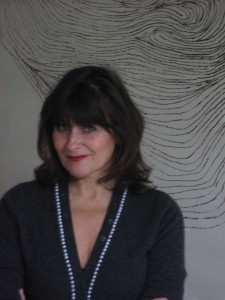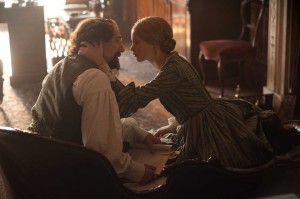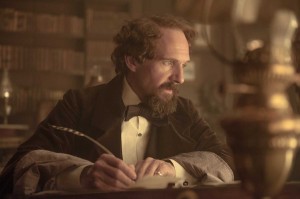
For modern audiences, The Invisible Woman represents a bit of double time travel. It’s the story of Nelly Ternan, a young actress who was Charles Dickens’ mistress when he was at the apex of his fame.
In Ralph Fiennes’ film – he plays Dickens, as well as directs – the story moves between the world of his fame, circa the 1850s, and the 1880s, after Dickens had died and Ternan had married.
For production designer Maria Djurkovic, one of the challenges was not only bringing an authentically Dickensian England to life, but the Victorian one that followed, and to convey to modern audiences the differences between those two 19th-centiury eras. After all, in another 150 years, will audiences recognize the distinct differences between 1950s’ and 1980s’ clothes, cars and appliances?
“I did an awful lot of research,” said Djurkovic, who previously had delved into the world of cold war spying in Tinker, Tailor, Soldier, Spy and into the 19th century for director Mira Nair’s adaptation of Vanity Fair among many other credits.
Reading Abi Morgan’s script, based on Claire Tomalin’s book, gave Djurkovic a “strong visual sense… a mood jumps out at you.” This nearly lead to a “suitcase full of books” jumping out at Fiennes during their first meeting, where, she said, “I had so much visual material. I did an awful lot of research.”
All of which paid off with the “quickest interview for an offer I’ve ever had.”

The intense research later manifested in trips to the Victoria & Albert museum, copies of paintings and lithographs and swatches of period wall paper – so beloved by English drawing room habitues of the Georgian and Victorian eras.
“We actually designed and printed our own wallpaper,” she said of the recreations. “It’s much cheaper to do that now than it used to be.”
But lush wallpapers aside, “people tend to see period in a slightly sepia way,” she noted. But not of course, those actually living through it. The color pallette of Nelly’s “present” in 1880s is different than the “cranked up volume in terms of color” that her own memories of Dickens hold.
Along with the colors, there were a lot of “ornate objects and clutter,” as she describes those interiors. “But the clutter tells stories, the design, a character.”
And happily, the correct clutter – whether an ornately framed mirror or overstuffed chair – wasn’t hard to come by, due to England’s “incredibly well-equipped prop houses, which have a wealth of stuff – especially in London.”
“There were so many different levels of how people lived,” she observed of the period, from the wealthy and the celebrated Dickens, on down to a “young woman on the border of respectability.”
 She explained that each set has to tell that at a glance. Of course, some of that glancing was at what people wore. People in the different decades wore “totally different types of frocks. I tried to delineate it further. People change their clothes all the time,” relative to how often they overhaul their furniture.
She explained that each set has to tell that at a glance. Of course, some of that glancing was at what people wore. People in the different decades wore “totally different types of frocks. I tried to delineate it further. People change their clothes all the time,” relative to how often they overhaul their furniture.
And yet, “the design was completely different than if I was designing one of Dickens’ stories.” In other words, the look of “The Old Curiosity Shop” would be different than this tale of the author, and his officially “invisible” mistress.
“There’s that heightened quality” in novels, she continues, whereas the task here was to recreate real life circa 1800s.
Djurkovic brings an old-fashioned approach to her work. “I draw very quickly,” she said, and goes through a lot of “pencils and pads, knocking out sketches.”
“It’s served me very well,” she added, “These drawings are taken by art directors and draftsmen,” and then turned into those story-telling sets.
Though another set piece – the Staplehurst Rail Crash of 1865, which involved Dickens, Ternan and her mother, did admittedly “lend itself to knocking out drawings on a computer.”
Overall, it was a “very happy shoot. Everyone got one with everyone else.” This was helped by everyone only working five days a week, though of course, they were full days, including Djurkovic and the location manager “in a car for hours on end.”
Once they found potential locations, director Fiennes would enact each scene, so they could see how the set worked, and how his portrayal of Dickens would move in his recreated world.
“That’s what I love about my job!” she declared. “I love the idea of creating a world that’s gone.”
Or to paraphrase Dickens, being someone “who could build a church (or recreate an era) by squinting at a piece of paper.” Or sketching on it.





